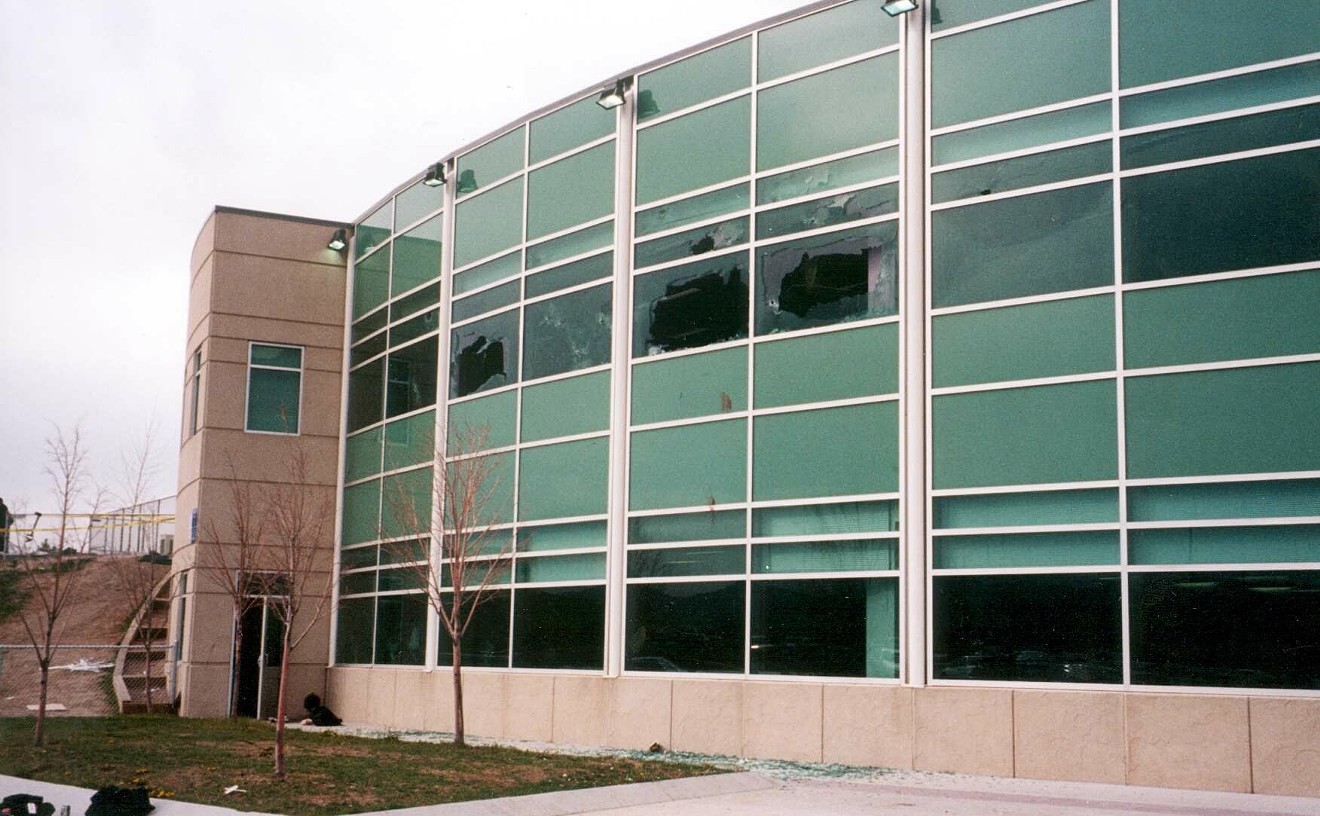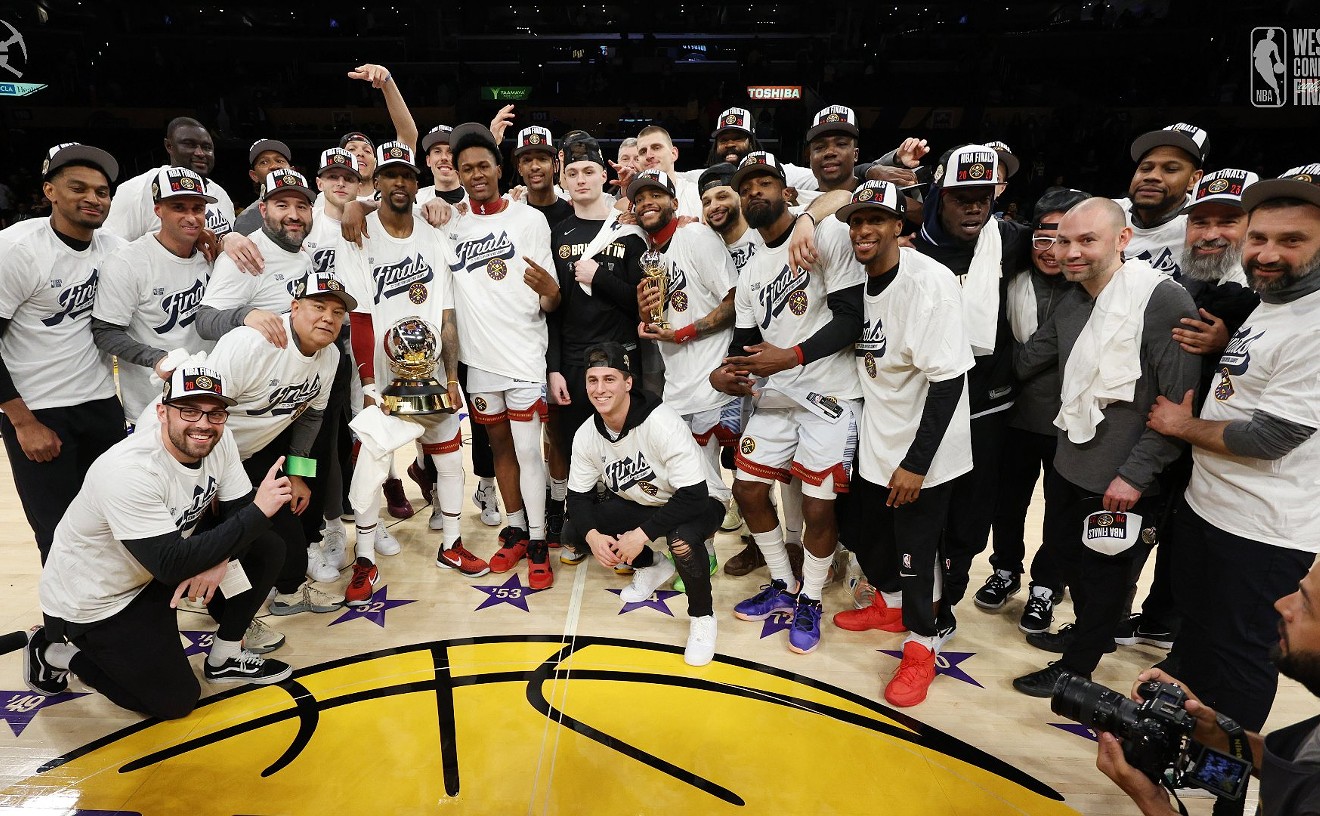She didn't know Eric Harris or Dylan Klebold.
Rebecca Beachy was sitting in photography class. The teacher had just begun taking attendance when the fire bell rang. Everyone thought it was a drill until they walked outside and a man yelled, "Run!"
She didn't know Eric or Dylan, either.
Krista Hanley was standing in the cafeteria line when she heard glass shatter and pipe bombs explode. She dove for cover with the rest of the students. And when the entire cafeteria "got up and moved as one," Krista escaped through the auditorium and down a hallway.
Eric and Dylan were her friends, but that's all she'll say.
There. Now that the obligatory information is out of the way, they'd like to talk about their art. Because that's what this should be about. But when you're a student at Columbine High School, the questions -- "Where were you?" and "Did you know them?" -- have become as common as blue- ribbon lapel pins. And when you're a student at Columbine, April 20, 1999, overshadows everything else.
Which is why Kim, Rebecca, Krista and another friend, Travis Hill, have organized an exhibition of "uncensored and unaffiliated" student art at Edge Gallery that runs through May 7, with a reception this Friday. The show, which features the work of ten teens, all Columbine students, offers what they hope is a more complete view of student life before, during and after the shootings.
"People think that Columbine is all we do and think about," says Rebecca. "There are times when it still gets difficult, but it's not even really talked about that much. There's more of an unspoken understanding than anything. You don't dwell on it every day."
Kim, Rebecca and Krista -- ages seventeen, seventeen and eighteen, respectively -- will graduate next month; they all plan to study art in college. This will be their final high school show, the culmination of four years of work. They've thought a lot about the exhibition -- what they wanted it to be, what they wanted it to say. From the beginning, they wanted it to be different. And from the beginning, they wanted it free of adult supervision.
Ever since the shootings, they've lived under a magnifying glass. Everything from their clothes to their CDs to their video games to their prom dates has been scrutinized, analyzed and discussed ad nauseam. Some days it's like everyone wants to protect them and protect their school, which is understandable and appreciated, but it can also be suffocating. "Everything at our school is so tightly controlled now," Rebecca says. "We don't have much freedom to say things, we don't have much freedom to wear things, we don't have much freedom in general."
That's why the show is "straight from the students," they say. "If we had help from other people, they would take a different view of what it should be," Rebecca explains. "Adults have a great view of how they want things, but I think we've seen that already. We wanted this to be about more than triumph, healing and therapy. All of that's true, but a lot of it has been romanticized and mythologized. We don't want it to be so obvious. That's all we've seen for the past year: obvious."
And the places they've seen that most often are the newspapers, TV and magazines. In the first days after the shootings, Rebecca, Kim and Krista couldn't walk down the sidewalk in front of the school without someone shoving a microphone, notebook or camera into their faces. With last week's anniversary, the circus arrived again.
"A lot of the media portrays us as not having moved on," Krista says. "This community is, like, stuck in the April 20 mode. When the media comes back and does more and more, it makes it harder to move on. And the whole school is totally moving on. Personally, I'd like to get away from the whole Columbine name. That's why I'm leaving the state to go to college. I don't want to be associated with it and the questions that come. I don't feel like I have to answer everyone over and over."
"There's almost a mold that reporters use," Rebecca adds. "They all use the right words, like 'tragedy' and 'remember.' They all try to evoke emotion. They all ask the same questions in the same way. And the people who really have something to say are the ones who don't talk to the media and are more skeptical of those things. After a while it just gets really old."
But it's not just the news media. At times the school district, the school administration, the parents and even many of the students have tailored the Columbine image. One example of that has been the officially sanctioned art shows.
"In the other Columbine shows, teachers decided what went into it," Kim says. "And it was all about what happened. And in all of the work, there was a columbine flower. It became almost like its own style. That's healing to the people who make it, but it's become almost trite, because each piece is saying the same exact thing: 'We Are Columbine.'"
"It was a lot of the same scrapbook stuff with newspaper articles and things about lost innocence," Rebecca adds. "And it's just not that interesting or articulate. And it could be."
They're not degrading others' work, though. And they're not saying that last April 20 didn't affect them. It did, and very deeply. But in very different ways.
Before the killings, Kim's art was bright, colorful and focused on themes like dreams and free-falling. One piece was called "Yellow Bubblemobile." But now her work is darker, more introspective and abstract. In a portrait called "Depth," a face hides behind a collage of shadows, reflections and flashes of color. "I don't think about the world the same way," Kim says. "Things aren't quite as beautiful. Or it's like they're still beautiful, but beautiful in a different way. To me, even some ugliness can be beautiful. Now my artwork is just what's inside my head. Uncovering layers that haven't been touched."
In the past, Rebecca's work usually made a statement, like her gutted-television sculpture named "Cold Static." But over the last year, her art became more organic, more textured and more intimate. For a piece called "Intrusion," she crafted a nest-like box from wasp's paper, then put in duck feathers, pine cones and a music-box mechanism that plays "I Did It My Way." In the center sits a live shotgun shell. "That's the intrusion," she says. "I like the idea that it hasn't gone off yet. It's about being selfish and taking things into your own hands and destroying what's beautiful. That was more about Columbine directly."
For most of her high school years, Krista photographed exclusively in black and white. Her favorite subjects were -- and still are -- flowers. But today she prefers color. "I used to see things in absolutes," she says. "Now I see almost everything as art. It's like everything has a beauty of its own. Before, I saw a lot more ugliness."
One of her most powerful pieces is "Steel Journal," which is exactly what the name suggests -- a black notebook of personal entries encased in sheet metal and bound with a chain and a combination lock. She made that right after April 20. "The pages are me and my emotions," Krista says. "And I really don't want anyone to see that. I only want people to see the outside. It's like, 'Don't come in.' But it's also intriguing for people not to be able to look inside. They'll pick it up and try to figure out how to get inside, but they can't without breaking it. It's just a reminder: 'Don't violate someone's privacy.'"
Their work isn't all brooding, haunting or confrontational, though. There are photos, collages, paintings and sculptures inspired by relationships, daily observations, life lessons and stuff they simply thought was cool. "If Columbine never happened, we'd still want people to see our work and listen to our opinions," Kim says. "One thing I learned this year is to listen to what other people have to say. And another thing I learned is to tell people how you feel. Our artwork is like our guts. It's how we communicate. And there are just so many other feelings and things going on in our lives besides Columbine."
And that's the point of this show. They are not victims. They are not survivors. They are not witnesses. They are not all Columbine. "What happened obviously affected us, but we don't want the tragedy to define who we are as people," Rebecca says. "It's not just that one event that created our image of ourselves. We're much more rounded than that. We're just high school kids."










